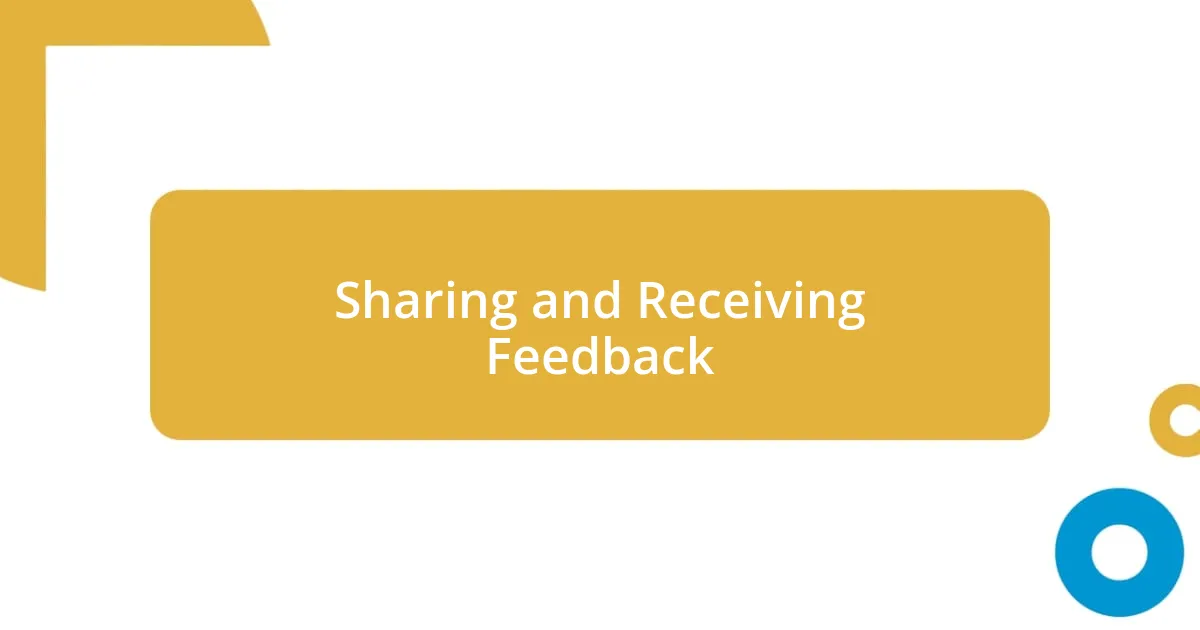Key takeaways:
- Inspiration for poetry often arises from everyday experiences, emotions, and changes in environment, demonstrating the power of observation.
- Establishing a consistent writing routine enhances creativity by providing structure and a conducive environment for reflection.
- Exploring various poetic forms and utilizing imagery and symbolism enriches emotional expression and deepens the reader’s engagement.
- Revising and sharing poetry fosters growth; feedback offers new perspectives while allowing for emotional connections and improvements in writing.

Finding Inspiration for Poetry
When I sit down to write poetry, I often find inspiration in the world around me. For instance, I remember one rainy afternoon when I watched droplets race down the windowpane. That simple moment stirred powerful images and emotions within me, leading to a poem about life’s unpredictability. Isn’t it fascinating how the smallest details can spark a cascade of thoughts and feelings?
Traveling often opens my eyes to new perspectives that fuel my creativity. I think back to a trip I took to the mountains, where the silence was deafening yet comforting. Surrounded by nature, I felt a deep connection to my own thoughts, leading me to explore themes of solitude and reflection in my work. Have you ever noticed how a change of scenery can shift your mindset?
Sometimes, my inspiration stems from the emotions I experience in daily life. For example, during a particularly challenging day at work, I penned a piece about frustration and resilience. Writing became my emotional outlet, transforming my struggles into art. Can you recall a time when your feelings drove you to create something beautiful? Embracing those moments can lead to poetry that resonates on a profound level.

Establishing a Writing Routine
Establishing a writing routine has been a game-changer for my poetry. I’ve realized that my creativity often flourishes when I provide it with structure. For me, setting aside specific times in the day—like early mornings with a steaming cup of tea—creates a sacred space for my thoughts to flow freely. This routine not only helps me stay consistent but also primes my mind for creativity, allowing me to tap into my emotions more easily.
Here are some strategies that work well for me in establishing a writing routine:
- Designate a specific writing time: Find what works best for you—whether it’s morning or evening—and stick to it.
- Create a comfortable writing environment: I like to write in a cozy nook with soft lighting and minimal distractions.
- Set realistic goals: I aim for a certain word count or complete a poem draft during each session, which helps me stay focused.
- Celebrate small wins: Completing even a single stanza feels rewarding and motivates me to keep going.
- Stay flexible: Life can be unpredictable, so I allow myself to adjust my schedule as needed without guilt.
By embracing these elements, I’ve found that my poetry not only flows more freely, but I also cultivate a deeper connection with my craft.

Exploring Different Poetic Forms
Exploring different poetic forms has truly enriched my writing journey. For instance, I discovered the haiku during a quiet afternoon at a park, where the simplicity of its structure challenged me to encapsulate an experience in just three lines. Writing haikus feels like painting a vivid picture with limited brushstrokes—every word must resonate. Have you ever felt constrained by form yet liberated in expression?
I also enjoy experimenting with free verse, which gives me the freedom to play with rhythm and structure. I remember composing a piece based on a conversation I overheard at a café, letting my thoughts flow without the confines of a set pattern. This fluidity allowed me to capture the essence of the moment, embodying the chaotic yet beautiful nature of our interactions. It reminds me that sometimes, breaking the rules can lead to the most authentic expression.
Lastly, I often revisit traditional forms like the sonnet, admiring their intricate rhyme schemes and meter. I wrote my first sonnet after being inspired by Shakespeare in high school—his ability to weave emotions into structured lines mesmerized me. The challenge of crafting precise imagery while adhering to a rhyme scheme deepened my appreciation for the craft. Have you tried writing in a specific form that pushed your creative boundaries?
| Poetic Form | Key Characteristics |
|---|---|
| Haiku | Three lines (5-7-5 syllables); focuses on nature, moments of beauty, simplicity. |
| Free Verse | No formal structure or rhyme; prioritizes natural speech patterns and creative freedom. |
| Sonnets | 14 lines; often in iambic pentameter, adhering to specific rhyme schemes (e.g., ABABCDCD). |

Utilizing Imagery and Symbolism
Utilizing imagery and symbolism in poetry has profoundly shaped my writing style. I often find that vivid images can transport readers to the very moment or feeling I’m trying to convey. For instance, when I wrote a piece about a fleeting summer afternoon, I described “the golden light spilling like honey over the grass.” This kind of imagery evokes not just a visual but also a sensory experience—can you picture it? It’s essential for me to pull readers into my world, allowing them to feel my emotions alongside me.
Symbolism, too, plays a critical role in adding layers to my poetry. In one poem, I used the motif of a broken clock to symbolize lost time and missed opportunities. I still remember the moments leading up to writing it—a somber feeling settled in as I reflected on choices I had made. The clock became more than a mere object; it embodied my struggles and regrets. When I weave such symbols into my work, I invite readers to draw their own meanings, prompting them to reflect on their experiences. Don’t you think symbols enrich a poem’s depth?
I often urge myself to be intentional about the imagery and symbols I choose. I’ve found that the more personal the image, the more impactful it is. When I penned a poem about my grandmother’s garden, I incorporated the smell of lavender and vibrant colors of marigolds. Those sensations trigger a flood of memories, making the writing process cathartic. It’s a reminder to continue exploring the world around me, looking for the little details that can transcend the page and resonate with others. What moments or symbols from your life would evoke a strong reaction if woven into your poetry?

Experimenting with Sound and Rhythm
Experimenting with sound and rhythm has been a personal exploration that deepens my connection to poetry. I remember the first time I tried reading my work aloud and noticed how the cadence could lift or ground a line. It felt like discovering a hidden dimension in my poetry—suddenly, the words weren’t just written symbols; they became melodies resonating in the air. Have you ever realized the power of sound in your writing?
I often play with alliteration and assonance, finding joy in how the repetition of consonant or vowel sounds can create a musical quality. For instance, during a late-night writing session, I crafted a poem about the ocean waves, which included phrases like “whispering waters” and “swaying shadows.” As I read it back, the rhythm danced off the page, allowing me to evoke a relaxing, soothing mood. It’s incredible how a few carefully chosen sounds can transform the emotional landscape of a poem.
In my journey, I’ve also experimented with varied line lengths to create tension and release. I remember composing a piece about change, where I alternated between short, punchy lines and longer, flowing statements. The shift in rhythm mirrored the push and pull of my own experiences, making it feel alive and dynamic. I often ask myself: how do the sounds and rhythms in my poetry mirror my emotional state? It’s a powerful way to engage both myself and my readers on a deeper level.

Revising and Editing Your Work
Revising and editing my poetry feels like going on a treasure hunt; it’s about finding the gems hidden in the rough. I can’t tell you how many drafts I’ve gone through for a single poem. I used to panic about getting everything perfect on the first try, but I’ve learned that bouncing back and forth through my work helps me unearth nuances I initially overlooked. For example, in one poem, I cut a whole stanza that seemed beautiful initially but disrupted the overall flow. Reflecting on that taught me the value of keeping only what truly serves the piece. What about you—do you find certain lines or stanzas hard to part with?
During my revision process, I love stepping away from my work for a little while. Taking breaks gives me fresh eyes when I return. I vividly recall one time when I left a poem untouched for a week; when I revisited it, much of what felt profound suddenly seemed clunky. I ended up rephrasing several lines, but what really sparked a transformation was uncovering the heart of the poem—what I wanted to express. It’s fascinating how time can shift our perspective, don’t you think?
Editing also reminds me that poetry is as much about precision as it is about emotion. I often scrutinize each word for clarity and impact. I remember laboring over the word “breathe” in a poem about solitude, deciding whether to use it as a verb or noun. This small choice changed the tone entirely! I’ve realized I need to be conscious of every word’s weight, understanding that even a slight adjustment can enhance or detract from the reader’s experience. How often do you reflect on the significance of your word choices?

Sharing and Receiving Feedback
Sharing my poetry with others has often felt like standing on a cliff, ready to leap into the unknown. It’s a vulnerable experience, opening up my work to scrutiny and suggestions. I remember the first poetry workshop I attended; I hesitated before sharing my piece, fully aware that the reactions could vary from praise to harsh critique. Yet, when I did share, the feedback I received not only honed my writing but also showed me different perspectives I hadn’t considered. How often do we shy away from opening ourselves up to criticism, even though it can be so rewarding?
Receiving feedback is not just about the words spoken; it’s about the emotional responses they evoke. I still recall a line from a fellow writer in one of my workshops: “Your poem has layers like an onion.” At first, I was perplexed, but breaking down my work into those layers made me realize how much depth I could explore. It was a profound moment for me, altering how I approached future pieces. Have you ever had a seemingly simple comment resonate with you on a deeper level?
On the flip side, sharing my poetry also taught me how to give feedback gracefully. I once made the mistake of critiquing a friend’s work too harshly, forgetting to highlight the strengths before diving into the areas for improvement. Reflecting on that experience made me realize the importance of balance—encouragement paired with constructive criticism fosters a more supportive environment. This approach has transformed my interactions; I now ask myself: how can I uplift another poet while helping them grow? That balance not only nurtures the creative spirit, but it also strengthens the bonds we form through our shared love of poetry.














